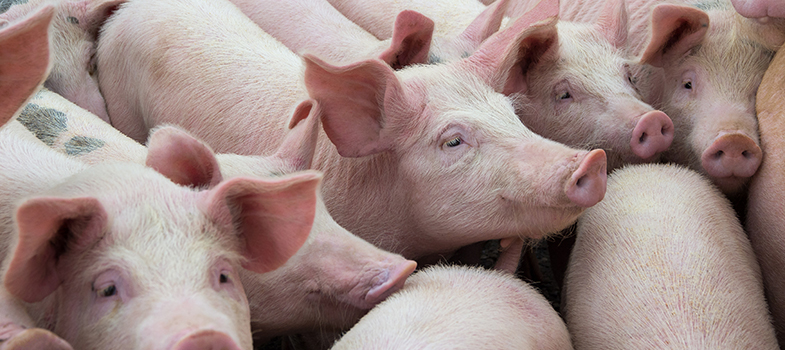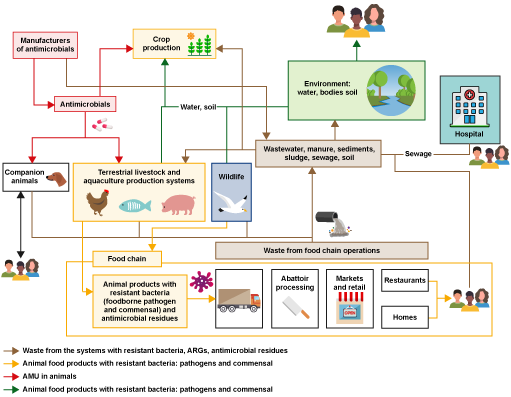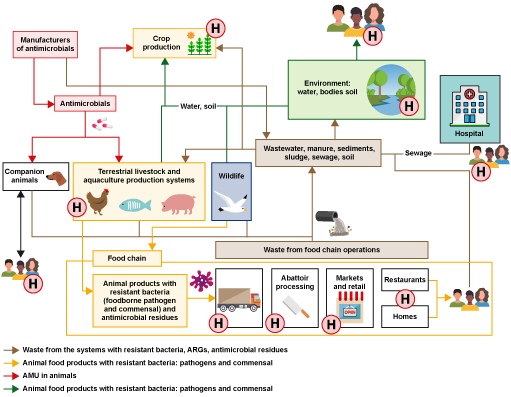2.3 Activities that increase the risk of AMR spread
A number of other factors are important in the emergence of resistance and spread of resistant bacteria and ARGs between humans, animals and the environment. It is important to note that resistant bacteria can be transmitted from humans to animals and vice versa. We have included some examples of key activities that promote AMR below.
Food animal production systems
In many countries it is common to use manure from poultry or pig farms to fertilise aquaculture ponds. Also, farmed ducks may swim in aquaculture settings. This practice can lead to the spread of resistant bacteria, ARGs and antimicrobial residues that can select for resistance in the aquaculture setting.
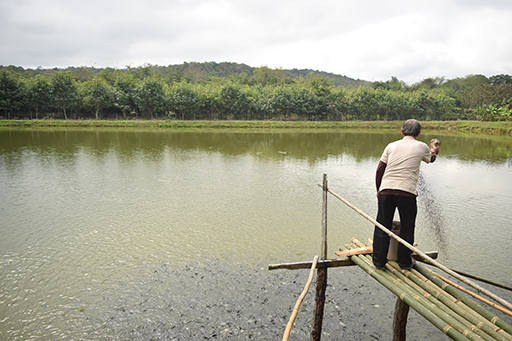
Hospitals and antimicrobial manufacturing
Wastewater and sewage from hospitals can contain high levels of resistant bacteria, ARGs and antimicrobial residues. Patients excrete bacteria in faeces and they may also excrete antimicrobial residues if they have received antimicrobial treatment. Antimicrobial manufacturing sites can also be hotspots for AMR spread, due to the potential release into the environment of ingredients that can select for resistance (Berendonk et al., 2015).
In the absence of water and waste treatment management, these human products can contaminate water courses and reach food producing animal systems. Recent studies have shown that ARGs in aquatic systems may be derived from human sources (Rowe et al., 2016).
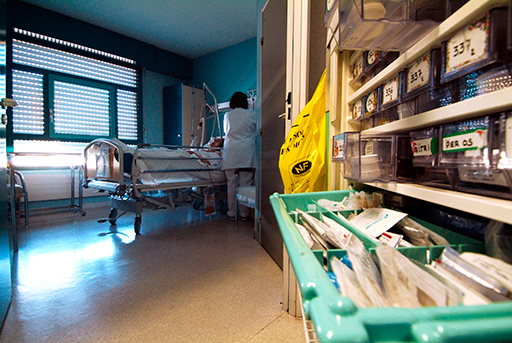
Figure 9 provides an overview of how AMR can spread, and the exposure types and transmission pathways that can lead to exposure of humans, animals and the environment to resistant bacteria, ARGs and antimicrobial residues, as explained in Sections 2.2 and 2.3. This figure can be used to identify activities that influence the emergence and transmission of resistant bacteria. For example, start with ‘antimicrobials’ near the top left of the diagram. The red arrows show that they can be administered to food animals and then the yellow arrows show that the resulting food products with resistant bacteria and antimicrobial residues can enter food chain operations such as abattoirs. The brown arrows show that waste from food chain operations can enter the environment, affecting soil, water and sediments (green arrows). Spend some time exploring the rest of the figure.
Activity 4: Types of exposure and transmission pathways
Looking at Figure 9, consider which points in the system might be particularly important for human exposure to resistant bacteria and antimicrobial residues (these could be described as ‘hotspots’). Use the space below to list the hotspots before looking at the discussion.
Discussion
There is a wide range of pathways by which humans can be exposed to resistant bacteria, ARGs and antimicrobial residues. Key points for human exposure are shown in Figure 10 – don’t worry if you didn’t identify all of them.
Activity 5: Human exposure and AMR transmission in your setting
Use the food production diagram you created in Activity 2 to complete this activity on paper or on a computer.
- Using the links you learnt about in Sections 2.2 and 2.3, add as many of them to your diagram as you can to show where resistant bacteria may be transmitted between animals, humans and the environment.
- Use a specific symbol (such as an H) to indicate where on your diagram humans might be exposed, including different types of occupational exposure and considering all relevant stakeholders.
Hint: remember to consider occupational, foodborne and environmental exposure.
Discussion
Occupations that you might have considered to be exposed to AMR include:
- farm workers in direct contact with the animals
- waste disposal workers, e.g. removing carcasses from the farm or removing faeces for fertiliser
- abattoir workers in contact with animal carcasses and organs contaminated with resistant bacteria.
- food processing workers who are in contact with animal products
- food retailers, e.g. at a market stall or shops
- veterinarians
- officials involved in e.g. farm and abattoir inspections.
The next section has an example of the type of diagram we had in mind; however, your diagram will be specific to your setting, and may be considerably simpler or laid out differently.
2.2 Types of human exposure to antimicrobials and resistant bacteria originating from animal systems

